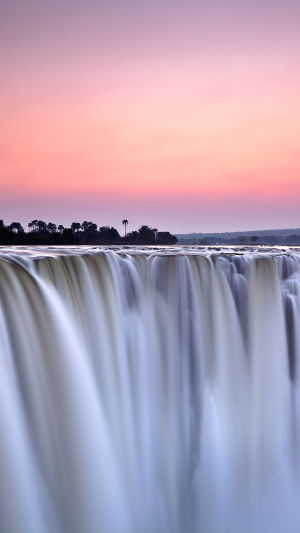Although Victoria Falls is neither the tallest nor the widest waterfall in the world.
Its combined width of 1708 meters and height of 108 meters make it the largest waterfall in the world.
Victoria Falls is approximate twice the height of Niagara Falls in North America.
The width of Victoria Falls is second only to Iguazu Falls in Argentina and Brazil.
This waterfall is shared by two countries, Zimbabwe and Zambia.
Two national parks have been built on either side of the falls.
The falls form a rainforest environment due to the huge rain and mist, and a large number of rare wild animals live there.
The hydroelectric power station built next to the falls provides power resources for both countries and is an important support for the local economy.
Victoria Falls, located on the border between Zambia and Zimbabwe, is the most famous feature of the Zambezi River and is the dividing line between the Upper and Lower Zambezi.
On the Zimbabwean side of the falls is called Victoria National Park, which covers an area of 23 square kilometers.
On the Zambian side of the falls is Mosi Otunya National Park, with an area of 66 square kilometers.
In the local Sotho language, this waterfall is called Mosi Otunya, which means thundering smoke.
The World Heritage List has adopted this name but recognizes both Victoria Falls and Mosi Otunya Falls.
The falls are also surrounded by the Battersea Game Reserve, the Kazuma Salt Marsh National Park, and the Yankee National Park to the south.
The national park that now surrounds Victoria Falls is part of the five-nation Kavango-Zambezi Transfrontier Conservation Area.v
The park is home to tall riparian forests and an abundance of wildlife, including elephants, giraffes, Grant's zebras, and a variety of antelopes.
The river above the falls has a large population of hippos and crocodiles.
African bush elephants come to the river to drink during the dry season.
Thirty-five species of raptors, including falcons and black eagles, can also be seen in the Zambezi River Gorge.
More than 100 species of fish live in this river.
A variety of birds are active in the woodlands and grasslands.
The spray from the waterfall and the watery and foggy environment created a special microcosm below the waterfall that surprisingly grew a small rainforest.
This miniature rainforest has mahogany, ebony, and some lianas growing in it.
These plants are extremely rare in the desert and savanna environments of the African highlands.
The formation and evolution of this microscopic rainforest ecosystem have amazed the biological community and ecologists.
Nature is amazing to create rainforests in deserts and savannas, which is a real and natural museum of desert highland rainforests.
The waters of the Zambezi River fall vertically into a deep gorge along a fracture zone of the basalt plateau to form Victoria Falls.
Above Victoria Falls, the river passes through an area of horizontal basalt.
Vast savannas dotted with green islands of forest and savanna dominate the vast flat area above the river.
As the river approaches the falls, the number of green islands increases.
Rocky islands at the top of the falls divide the curtain of water into multiple streams when there is insufficient flooding.
On the Zambezi River Falls Observation Bridge, the sight of this rain mist will be even more stunning, and many visitors come to the bridge just to experience the feeling of this water spraying on their bodies.
Such a wonderful experience, do not go to the scene to experience it once.





